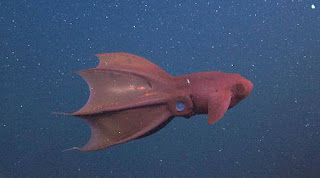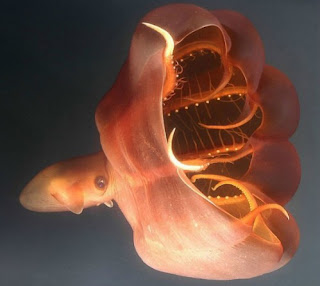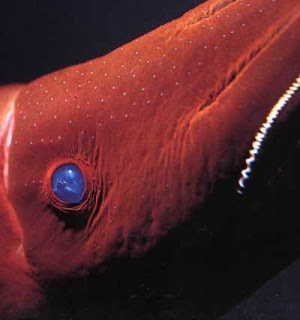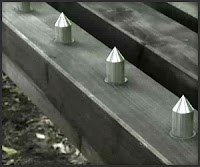Vampire Squids Are Not Vampish About Meals
Close to a century ago, the public was first treated to glimpses on a vampire squid. Today this mysterious deep sea creature continues to intrigue people (judged by the number of scientific papers being published since the first sighting) but not much has been said about its daily diet.
This changes when Henk-Jan Hoving and Bruce Robison published a paper that shed light into this subject. Unlike others in the family (think squids and octopuses), vampire squid does not feast on live prey. Instead its main staple is bits of organic debris and it uses its two filaments that are thread-like to take out the debris as it makes its way from the surface of the ocean down into deep sea.
Image [Click to enlarge]
It is easy to assume that vampire squid will be some form of scary predator. It operates in the depth of deep sea; it has a body that is dark red in color, and possesses imposing blue eyes. When it senses that it is under threat, it turns inside-out, and the 8 tentacles quickly turn into rows of wicked "cirri". It does take much imagination to conjure up that image of fearful object. The scientific name of the vampire squid, Vampyroteuthis infernalis, says it all. The phrase literally means "vampire squid from hell".
Image [Click to enlarge]
The truth is that vampire squid has a soft body and it is almost harmless. It assumes the color, shape and size of an old-fashion football. It has earned the name "living fossil" as its presence has never really been threatened by extinction. This probably has a lot to do with its hostile habitat. They thrive at the deepest of ocean basins of the world where oxygen is in serious short supply. But this also works in its favor as it means that there are relatively fewer natural predators.
Previously, marine researchers have tried to make sense of what they used to eat, and the approach had been cutting open their stomachs and examining the content. Unfortunately such analysis was not helpful.
Image [Click to enlarge]
In an interview with the Proceedings of the Royal Society B: Biological Sciences, Robison and Hoving explained that the main diet consists of a mixture of snot, dead bodies and poop, together referred to as "marine snow". Dead bodies here refer to the remnants of animals and microscopic algae which survive closer to the ocean surface, but descend into the deep sea bed upon their death. The snot is simply debris from gelatinous creatures like larvaceans. The poop is nothing more than fecal pellets from various small, shrimp-like creatures, krill or copepods, for example.
Other than checking out the stomach-contents (instead of conventional approach which forced a knife through the stomach, Robison and Hoving went to the museum to collect this information), they also used MBARI's ROVs (short for remotely operated vehicles) to capture vampire squids alive and place them in the lab to study their eating habits. For a balanced analysis, they also made use of high-definition video cameras installed on MBARI's ROVs to scrutinize the feasting pattern of vampire squid in the deep sea. Finally, they extended their examination to the squid's feeding filaments and arms, with the help of scanning and optical electron microscopes.
Video
One major advantage of laboratory examination is that the researchers can inspect the eating habit up close. Soon they discovered that whatever bits of microscopic organisms poured into the tank would somehow stick to the filaments that vampire squid extends out from time to time. These tiny particles would then be removed from the filament with the arms and a layer of mucus would soon be seen surrounding the particles. The vampire squid would finally complete the cycle by transferring the mucus to mouth and eat it.
Inside the deep sea, video footage revealed drifting vampire squids tend to extend their filaments (filaments are thin) – on average about 8 times longer than the body of the animal. Upon closer inspection, marine snow bits were seen sticking to those thin filaments. As in the case of the squids inside the lab, the creatures subsequently transfer the marine snow with their arms. Mucus globs were also captured by the cameras, either sticking to the body or swinging from their mouths.
Image [Click to enlarge]
With the help of microscope, these researchers soon discovered that the filaments of vampire squid were full of mucus producing cells. They are also covered with very small hairs (which explain the sticking effects) and a fairly developed network of sensory nerves.
With all these evidences considered, Hoving and Robison came to the following conclusion: "the vampire squid's filament is likely a multifunctional organ that is deployed to detect and capture detrital matter but at the same time may detect the presence of predators and perhaps small living prey". The diet may not be something that can be described as fulfilling or nutritious, but this is adequately compensated by a lifestyle that is extremely energy-efficient and full of unique adaptations.
Finally, the hostile and oxygen deprived environment which vampire squids inhabit means that there is little chance of other creature in this zone, let alone its natural predators. As such there is little provision for energy to escape from predators, and the food available is considered abundant given its frugal diet.







Comments
Post a Comment